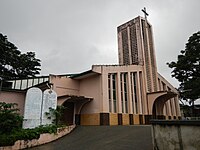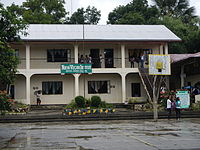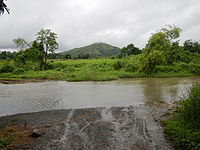Aritao | |
|---|---|
| Municipality of Aritao | |
 Downtown area | |
 Map of Nueva Vizcaya with Aritao highlighted | |
Location within the
Philippines | |
| Coordinates: 16°17′50″N 121°02′02″E / 16.297258°N 121.033819°E | |
| Country | Philippines |
| Region | Cagayan Valley |
| Province | Nueva Vizcaya |
| District | Lone district |
| Barangays | 22 (see Barangays) |
| Government | |
| • Type | Sangguniang Bayan |
| • Mayor | Remelina M. Peros |
| • Vice Mayor | Jayson Ferrer. |
| • Representative | Luisa L. Cuaresma |
| • Electorate | 23,422 voters ( 2022) |
| Area | |
| • Total | 265.60 km2 (102.55 sq mi) |
| Elevation | 476 m (1,562 ft) |
| Highest elevation | 846 m (2,776 ft) |
| Lowest elevation | 346 m (1,135 ft) |
| Population (2020 census)
[3] | |
| • Total | 42,197 |
| • Density | 160/km2 (410/sq mi) |
| • Households | 10,307 |
| Economy | |
| • Income class | 2nd municipal income class |
| • Poverty incidence | 15.83 |
| • Revenue | ₱ 198.3 million (2020) |
| • Assets | ₱ 380.5 million (2020) |
| • Expenditure | ₱ 156 million (2020) |
| • Liabilities | ₱ 53.84 million (2020) |
| Service provider | |
| • Electricity | Nueva Vizcaya Electric Cooperative (NUVELCO) |
| Time zone | UTC+8 ( PST) |
| ZIP code | 3704 |
| PSGC | |
| IDD : area code | +63 (0)78 |
| Native languages | Gaddang Ilocano Isinai Kallahan Tagalog |
| Website |
aritao |
Aritao, officially the Municipality of Aritao ( Gaddang: Ili na Aritao; Ilocano: Ili ti Aritao; Tagalog: Bayan ng Aritao), is a 2nd class municipality in the province of Nueva Vizcaya, Philippines. According to the 2020 census, it has a population of 42,197 people. [3]
The ethnic minority called Isinai (the same term for the local spoken dialect) were the original residents of this town.
Aritao is 30 kilometres (19 mi) from Bayombong and 235 kilometres (146 mi) from Manila.
Etymology
The name Aritao came from the Isinai phrase Ari Tau "which stands for "Our King" (ari means king and tau means our) which refers to the legendary Isinai Chieftain Mengal, a fierce and brave king who resisted Spanish conquest of the Isinai territories around Ajanas and Ynordenan (the areas comprising what is now most of Aritao).
History
The town of Aritao was previously called Ajanas or Afanas. It was formerly the site of an Igorot fortress that was overrun by the Spanish in 1745 which was then further fortified by the colonists. Prior to that, the Spaniards had already established their first permanent settlement in Nueva Vizcaya in 1714 in the town of Buhay, now Barangay Santa Clara. Afanas was later renamedto Aritao, after an Isinay word “Ari-Tau”. In January 1767, the intrepid Spanish Missionary Manuel Corripio succeeded in persuading an Igorot King called Ari Mengal and his tribe to live in the town. These people were later converted into Christianity by Fr. Tomas Gutierrez. In 1776, there was a merger of Aritao with the settlements of Buhay, Mabatu and Pahipahi into one pueblo under the name of Aritao, which was approved by the colonial authorities, with the town center being confirmed to be in the old Aritao. [5]
During the American Era on 30 June 1917, through the initiative of Councilor Jose Aleman, the application for township of Aritao to higher authorities was finally approved by the Secretary of the Interior.
During World War II, Japanese troops entered Aritao in 1942 and were pushed out by Allied forces in 1945 after heavy fighting in the village of Kirang, which lay on the foot of the Cordillera mountain trails towards Baguio.
Geography
Barangays
Aritao is politically subdivided into 22 barangays. Each barangay consists of puroks and some have sitios.
- Banganan
- Beti
- Bone North
- Bone South
- Calitlitan
- Comon
- Cutar
- Darapidap
- Kirang
- Nagcuartelan
- Poblacion
- Sta. Clara
- Tabueng
- Tucanon
- Anayo
- Baan
- Balite
- Canabuan
- Canarem
- Latar-Nocnoc-San Francisco
- Ocao-Capiniaan
- Yaway
Climate
| Climate data for Aritao, Nueva Vizcaya | |||||||||||||
|---|---|---|---|---|---|---|---|---|---|---|---|---|---|
| Month | Jan | Feb | Mar | Apr | May | Jun | Jul | Aug | Sep | Oct | Nov | Dec | Year |
| Mean daily maximum °C (°F) | 26 (79) |
28 (82) |
29 (84) |
31 (88) |
30 (86) |
29 (84) |
28 (82) |
28 (82) |
28 (82) |
28 (82) |
28 (82) |
27 (81) |
28 (83) |
| Mean daily minimum °C (°F) | 18 (64) |
18 (64) |
19 (66) |
22 (72) |
23 (73) |
23 (73) |
23 (73) |
23 (73) |
23 (73) |
21 (70) |
20 (68) |
18 (64) |
21 (69) |
| Average precipitation mm (inches) | 21 (0.8) |
28 (1.1) |
34 (1.3) |
58 (2.3) |
160 (6.3) |
179 (7.0) |
226 (8.9) |
225 (8.9) |
215 (8.5) |
168 (6.6) |
59 (2.3) |
32 (1.3) |
1,405 (55.3) |
| Average rainy days | 7.5 | 8.5 | 10.9 | 14.9 | 23.9 | 25.7 | 26.7 | 25.3 | 24.9 | 18.6 | 11.8 | 8.9 | 207.6 |
| Source: Meteoblue [6] | |||||||||||||
Demographics
|
| |||||||||||||||||||||||||||||||||||||||||||||||||||
| Source: Philippine Statistics Authority [7] [8] [9] [10] | ||||||||||||||||||||||||||||||||||||||||||||||||||||
Economy
Graphs are unavailable due to technical issues. There is more info on
Phabricator and on
MediaWiki.org. |
Government
Local government
Aritao, belonging to the lone congressional district of the province of Nueva Vizcaya, is governed by a mayor designated as its local chief executive and by a municipal council as its legislative body in accordance with the Local Government Code. The mayor, vice mayor, and the councilors are elected directly by the people through an election which is being held every three years.
Elected officials
| Position | Name |
|---|---|
| Congressman | Luisa L. Cuaresma |
| Mayor | Remelina M. Peros-Galam |
| Vice-Mayor | Jayson E. Ferrer |
| Councilors | Ariel M. Tubiera |
| Aura Bless Crisel F. Galindez | |
| Adonis J. Lejao | |
| Cyrus Will C. Cardenas | |
| Domingo B. Doculan Jr. | |
| Michael M. Villegas | |
| Bernel A. Prado | |
| Vincent L. Lopez |
Education
The Schools Division of Nueva Vizcaya governs the town's public education system. The division office is a field office of the DepEd in Cagayan Valley region. [19] The office governs the public and private elementary and public and private high schools throughout the municipality.
- Aritao National High School
- Immaculate Conception Academy
- Saint Teresita's Academy
- Nueva Vizcaya Institute
- Santa Clara High School
Gallery
-
St. Anthony de Padua Chapel
-
Nueva Vizcaya Institute
-
Twin (Skull and Salakot) mountains (visible from Aritao Townhall)
References
- ^ Municipality of Aritao | (DILG)
- ^ "2015 Census of Population, Report No. 3 – Population, Land Area, and Population Density" (PDF). Philippine Statistics Authority. Quezon City, Philippines. August 2016. ISSN 0117-1453. Archived (PDF) from the original on May 25, 2021. Retrieved July 16, 2021.
- ^ a b Census of Population (2020). "Region II (Cagayan Valley)". Total Population by Province, City, Municipality and Barangay. Philippine Statistics Authority. Retrieved 8 July 2021.
- ^ "PSA Releases the 2018 Municipal and City Level Poverty Estimates". Philippine Statistics Authority. 15 December 2021. Retrieved 22 January 2022.
- ^ Salgado, Pedro. "Various Towns of Nueva Vizcaya". Cagayan Valley and Easter Cordillera: 1581-1898, Volume II. Rex Publishing. pp. 804–809.
- ^ "Aritao: Average Temperatures and Rainfall". Meteoblue. Retrieved 4 July 2021.
- ^ Census of Population (2015). "Region II (Cagayan Valley)". Total Population by Province, City, Municipality and Barangay. Philippine Statistics Authority. Retrieved 20 June 2016.
- ^ Census of Population and Housing (2010). "Region II (Cagayan Valley)" (PDF). Total Population by Province, City, Municipality and Barangay. National Statistics Office. Retrieved 29 June 2016.
-
^ Censuses of Population (1903–2007).
"Region II (Cagayan Valley)".
Table 1. Population Enumerated in Various Censuses by Province/Highly Urbanized City: 1903 to 2007.
National Statistics Office.
{{ cite encyclopedia}}: CS1 maint: numeric names: authors list ( link) - ^ "Province of Nueva Vizcaya". Municipality Population Data. Local Water Utilities Administration Research Division. Retrieved 17 December 2016.
- ^ "Poverty incidence (PI):". Philippine Statistics Authority. Retrieved December 28, 2020.
- ^ "Estimation of Local Poverty in the Philippines" (PDF). Philippine Statistics Authority. 29 November 2005.
- ^ "2003 City and Municipal Level Poverty Estimates" (PDF). Philippine Statistics Authority. 23 March 2009.
- ^ "City and Municipal Level Poverty Estimates; 2006 and 2009" (PDF). Philippine Statistics Authority. 3 August 2012.
- ^ "2012 Municipal and City Level Poverty Estimates" (PDF). Philippine Statistics Authority. 31 May 2016.
- ^ "Municipal and City Level Small Area Poverty Estimates; 2009, 2012 and 2015". Philippine Statistics Authority. 10 July 2019.
- ^ "PSA Releases the 2018 Municipal and City Level Poverty Estimates". Philippine Statistics Authority. 15 December 2021. Retrieved 22 January 2022.
-
^
"LGU-Officials | Official Website of LGU Aritao". Official Website of LGU Aritao. Retrieved 10 April 2024.
{{ cite web}}: CS1 maint: url-status ( link) - ^ "DEPED REGIONAL OFFICE NO. 02". DepED RO2 | The official website of DepED Regional Office No. 02. Archived from the original on 2022-04-12. Retrieved 2022-03-12.







